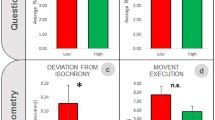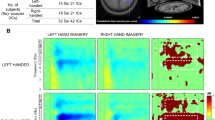Abstract
Existing brain-computer interface (BCI) research has made great progress in improving the accuracy and information transfer rate (ITR) of BCI systems. However, the practicability of BCI is still difficult to achieve. One of the important reasons for this difficulty is that human factors are not fully considered in the research and development of BCI. As a result, BCI systems have not yet reached users’ expectations. In this study, we investigate a BCI system of motor imagery for lower limb synchronous rehabilitation as an example. From the perspective of human factors engineering of BCI, a comprehensive evaluation method of BCI system development is proposed based on the concept of human-centered design and evaluation. Subjects’ satisfaction ratings for BCI sensors, visual analog scale (VAS), subjects’ satisfaction rating of the BCI system, and the mental workload rating for subjects manipulating the BCI system, as well as interview/follow-up comprehensive evaluation of motor imagery of BCI (MI-BCI) system satisfaction were used. The methods and concepts proposed in this study provide useful insights for the design of personalized MI-BCI. We expect that the human factors engineering of BCI could be applied to the design and satisfaction evaluation of MI-BCI, so as to promote the practical application of this kind of BCI.




Similar content being viewed by others
Data availability
The data used to support the findings of this study are included in this article, and the corresponding authors can be contacted for further inquiries.
References
Abiri R, Borhani S, Kilmarx J, Esterwood C, Jiang Y, Zhao X (2020) A usability study of low-cost wireless brain-computer interface for cursor control using online linear model. IEEE T Hum-Mach Syst 50(4):287–297
Alazrai R, Alwanni H, Daoud M (2019) EEG-based BCI system for decoding finger movements within the same hand. Neurosci Lett 698:113–120
Allison BZ, Dunne S, Leeb R, Millán JDR, Nijholt A (2012) Towards practical brain-computer interfaces: bridging the gap from research to real-world applications. Springer Publishing Company, Berlin
Blankertz B et al (2010) The Berlin brain-computer interface: non-medical uses of BCI technology. Front Neurosci 4:198
Branco MPA, Pels EGMA, SarsAarnoutse RHABEJA, Ramsey NFA, Vansteensel MJA, Nijboer FBC (2021) Brain-computer interfaces for communication: preferences of individuals with locked-in syndrome. Neurorehab Neural Re 35(3):267–279
Chan S, Chan A (2006) The validity and applicability of the Chinese version of the quebec user evaluation of satisfaction with assistive technology for people with spinal cord injury. Assist Technol 18(1):25–33
Chavarriaga R, Fried-Oken M, Kleih S, Lotte F, Scherer R (2017) Heading for new shores! Overcoming pitfalls in BCI design. Brain Comput Interfaces 4(1–2):60–73
Choi I, Rhiu I, Lee Y, Yun MH, Nam CS (2017) A systematic review of hybrid brain-computer interfaces: taxonomy and usability perspectives. PLoS ONE 12(4):e0176674
Colucci M, Tofani M, Trioschi D, Guarino D, Berardi A, Galeoto G (2021) Reliability and validity of the Italian version of quebec user evaluation of satisfaction with assistive technology 2.0 (QUEST-IT 2.0) with users of mobility assistive device. Disabil Rehabil 16(3):251–254
Daneshi A, Azarnoush H, Towhidkhah F, Bernardin D, Faubert J (2020) Brain activity during time to contact estimation: an EEG study. Cogn Neurodyn 14:155–168
Fu J, Jiao X, Cao Y, Jiang J, Li Q, Feng J (2020) EEG-based study on mental workload in multi-factor cognitive tasks space. Med Med Eng 33(1):35–44
Galán F, Nuttin M, Lew E, Ferrez PW, Vanacker G, Philips J, Millán JDR (2008) A brain-actuated wheelchair: asynchronous and non-invasive brain-computer interfaces for continuous control of robots. Clin Neurophysiol 119(9):2159–2169
Graimann B, Allison B, Pfurtscheller G (2013) Brain-computer interfaces: revolutionizing human-computer interaction. Springer Publishing Company, Berlin
Guger C, Edlinger G, Harkam W (2003) How many people are able to operate an EEG-based brain-computer interface (BCI)? IEEE Trans Neural Syst Rehabil 11(2):145–147
Hart SG, Staveland LE (1988) Development of NASA-TLX (task load index): results of empirical and theoretical research. Adv Psychol 52:139–183
Holz EM, Höhne J, Staiger-Sälzer P (2013) Brain-computer interface controlled gaming: evaluation of usability by severely motor restricted end-users. Artif Intell Med 59(2):111–120
Jeunet C, et al (2021) Modelling the acceptance of BCI-based stroke rehabilitation procedures: heading for efficiently personalised therapies. BCI Meeting 2021. https://hal.archives-ouvertes.fr/hal-03331687. Accessed Sep 2021
Kübler A (2013) Brain-computer interfacing-science fiction has come true. Brain 136(6):2001–2004
Kübler A (2019) The history of BCI: from a vision for the future to real support for personhood in people with locked-in syndrome. Neuroethics 13(2):1–18
Kübler A, Zickler C, Holz E, Kaufmann T, Riccio A, Mattia D (2013) Applying the user-centred design to evaluation of brain-computer interface controlled applications. Biomed Eng-Biomed Te 58(15):3234–3234
Kübler A et al (2014) The user-centered design as novel perspective for evaluating the usability of BCI-controlled applications. PLoS ONE 9(12):e112392
Kübler A, Nijboer F, Kleih S (2020) Hearing the needs of clinical users. Handb Clin Neurol 168:353–368
Lee MH, Kwon OY, Kim YJ, Kim HK, Lee YE, Williamson J, Fazli S, Lee SW (2019) EEG dataset and OpenBMI toolbox for three BCI paradigms: an investigation into BCI illiteracy. Giga Sci 8(5):1–16
Liberati G, Pizzimenti A, Simione L, Riccio A, Schettini F, Inghilleri M, Mattia D, Cincotti F (2015) Developing brain-computer interfaces from a user-centered perspective: assessing the needs of persons with amyotrophic lateral sclerosis, caregivers and professionals. Appl Ergon 50:139–146
Lu X, Ding P, Li S, Gong A, Zhao L, Qian Q, Su L, Fu Y (2021) Human factors engineering of brain-computer interface and its applications: human-centered brain-computer interface design and evaluation methodology. J Biomed Eng 38(2):210–223
Martin S, Armstrong E, Thomson E, Vargiu E, Sola’ M, Dauwalder S, Miralles F, Daly Lynn J (2018) A qualitative study adopting a user-centered approach to design and validate a brain computer interface for cognitive rehabilitation for people with brain injury. Assist Technol 30(5):233–241
Miao Y, Yin E, Allison BZ, Zhang Y, Chen Y, Dong Y, Wang X, Hu D, Chchocki A, Jin J (2020) An ERP-based BCI with peripheral stimuli: validation with ALS patients. Cogn Neurodyn 14:21–33
Millan JDR, Renkens F, Mourino J, Gerstner W (2004) Noninvasive brain-actuated control of a mobile robot by human EEG. IEEE Trans Biomed Eng 51(6):1026–1033
Miralles F et al (2015) Brain computer interface on track to home. Sci World J 2(1):1
Muhammad E (2011) Rapid prototyping technology: principles and functional requirements. IntechOpen, London
Riccio A et al (2016) Interfacing brain with computer to improve communication and rehabilitation after brain damage. Prog Brain Res 228(1):357–387
Schreudera M, Ricciob A, Risettib M, Dähnea S, Ramsayd A, Williamsond J, Mattiab D, Tangermanne M (2013) User-centered design in brain-computer interfaces-a case study. Artif Intell Med 59(2):71–80
Thompson MC (2019) Critiquing the concept of BCI illiteracy. Sci Eng Ethics 25(4):1217–1233
Tian G et al (2021) Execution, assessment and improvement methods of motor imagery for brain-computer interface. J Biomed Eng 38(3):434–446
Wang X, Jin J, Zhang Y, Wang B (2013) Brain control: human-computer integration control based on brain-computer interface. Acta Autom Sin 39(3):208–221
Wang Z, Chen L, He F, Wan B, Ming D (2017) Development trend and prospect of BCI technology facing rehabilitation and assisting applications. Chin J Sci Instrum 38(6):1307–1318
Wang K, Xu M, Wang Y, Zhang S, Chen L, Ming D (2020) Enhance decoding of pre-movement EEG patterns for brain-computer interfaces. J Neural Eng 17(1):016033
Wolpaw JR, Wolpaw EW (2012) Brain-computer interfaces: principles and practice. Oxford University Press, Oxford
Wolpaw JR, Millán JDR, Ramsey NF (2020) Brain-computer interfaces: definitions and principles. Handb Clin Neurol 168:15–23
Xu M, He F, Jung TP, Gu X, Ming D (2021) Current challenges for the practical application of electroencephalography-based brain–computer interfaces. Engineering 7(12):1710–1712
Zickler C et al (2011) A brain-computer interface as input channel for a standard assistive technology software. Clin EEG Neurosci 42(4):236–244
Zickler C, Halder S, Kleih SC, Herbert C, Kübler A (2013) Brain painting: Usability testing according to the user-centered design in end users with severe motor paralysis. Artif Intell Med 59(2):99–110
Zjajo A (2016) Brain-machine interface: circuits and systems. Springer Publishing Company, Berlin
Funding
This study was supported by the National Natural Science Foundation of China (81771926, 61763022, 81470084, 61463024, 62006246, 82172058).
Author information
Authors and Affiliations
Contributions
XL: experimental design, data collection and analysis, experimental results visualization and paper writing; SL and YD: data curation and analysis; PD and AG: review and revision of the paper; LS: supervision and guidance; LZ: Experimental design validation and verification; YF: Funding support and paper revision. All authors have made significant contributions to the submission and have agreed to the final version of the manuscript.
Corresponding author
Ethics declarations
Conflict of interest
All authors of this article declare that there is no conflict of interest.
Ethical statement
The studies involving human participants were reviewed and approved by Medical Ethics Committee of Kunming University of Science and Technology School of Medicine. The research was conducted in accordance with the principles embodied in the Declaration of Helsinki and in accordance with local statutory requirements. All participants provided their written informed consent to participate in this study. Written informed consent was obtained from the individuals for the publication of any potentially identifiable images or data included in this article.
Additional information
Publisher's Note
Springer Nature remains neutral with regard to jurisdictional claims in published maps and institutional affiliations.
Rights and permissions
About this article
Cite this article
Lyu, X., Ding, P., Li, S. et al. Human factors engineering of BCI: an evaluation for satisfaction of BCI based on motor imagery. Cogn Neurodyn 17, 105–118 (2023). https://doi.org/10.1007/s11571-022-09808-z
Received:
Revised:
Accepted:
Published:
Issue Date:
DOI: https://doi.org/10.1007/s11571-022-09808-z




